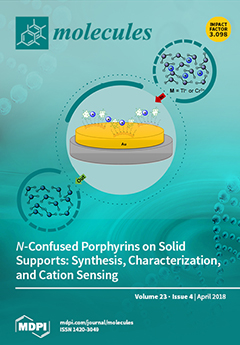In this study, two natural phenolic polyamines, kukoamine A and B, were comparatively investigated for their antioxidant and cytoprotective effects in Fenton-damaged bone marrow-derived mesenchymal stem cells (bmMSCs). When compared with kukoamine B, kukoamine A consistently demonstrated higher IC
50 values in PTIO•-scavenging
[...] Read more.
In this study, two natural phenolic polyamines, kukoamine A and B, were comparatively investigated for their antioxidant and cytoprotective effects in Fenton-damaged bone marrow-derived mesenchymal stem cells (bmMSCs). When compared with kukoamine B, kukoamine A consistently demonstrated higher IC
50 values in PTIO•-scavenging (pH 7.4), Cu
2+-reducing, DPPH•-scavenging, •O
2−-scavenging, and •OH-scavenging assays. However, in the PTIO•-scavenging assay, the IC
50 values of each kukoamine varied with pH value. In the Fe
2+-chelating assay, kukoamine B presented greater UV-Vis absorption and darker color than kukoamine A. In the HPLC–ESI–MS/MS analysis, kukoamine A with DPPH• produced radical-adduct-formation (RAF) peaks (
m/
z 922 and 713). The 3-(4,5-Dimethylthiazol-2-yl)-2,5-diphenyl (MTT) assay suggested that both kukoamines concentration-dependently increased the viabilities of Fenton-damaged bmMSCs at 56.5–188.4 μM. However, kukoamine A showed lower viability percentages than kukoamine B. In conclusion, the two isomers kukoamine A and B can protect bmMSCs from Fenton-induced damage, possibly through direct or indirect antioxidant pathways, including electron-transfer, proton-transfer, hydrogen atom transfer, RAF, and Fe
2+-chelating. Since kukoamine B possesses higher potentials than kukoamine A in these pathways, kukoamine B is thus superior to kukoamine A in terms of cytoprotection. These differences can ultimately be attributed to positional isomeric effects.
Full article






